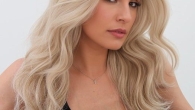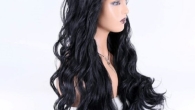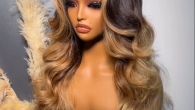
How to Care for a Synthetic Wig: A Comprehensive Guide
Synthetic wigs offer a convenient and stylish hair solution. However, proper care is essential to maintain their appearance and longevity. This guide will provide you with comprehensive information on how to care for your synthetic wig, from washing and conditioning to styling and storage. By following these tips, you can ensure your wig looks its best for years to come.
Understanding Synthetic Wigs
Before diving into care routines, it’s important to understand the unique characteristics of synthetic wigs. Synthetic fibers are created to mimic human hair, but they have different properties. They are less prone to damage from heat styling tools but can be more susceptible to tangling and dryness.
Washing Your Synthetic Wig
Regular washing is crucial for maintaining the health of your synthetic wig. Follow these steps for a gentle cleaning:

- Fill a sink or basin: With lukewarm water.
- Add wig shampoo: Use a wig-specific shampoo or a gentle, sulfate-free hair cleanser.
- Soak the wig: Immerse the wig in the soapy water for 5-10 minutes, gently swishing it around.
- Rinse thoroughly: Remove the wig from the water and rinse it gently under lukewarm water until all the shampoo is removed.
- Conditioning: Apply a small amount of wig conditioner or hair conditioner to the ends of the wig. Avoid applying conditioner to the roots.
- Drying: Gently squeeze out excess water with a towel. Avoid rubbing or wringing the wig. Place the wig on a wig stand or a clean towel to air dry completely.
Detangling Your Synthetic Wig
To prevent tangles and maintain a smooth appearance, detangle your wig regularly using the following steps:
- Use a wide-tooth comb or wig brush: These tools are specifically designed for synthetic hair and help to minimize damage.
- Start at the ends: Begin combing or brushing at the ends of the wig and gradually work your way up to the roots.
- Gentle strokes: Use gentle strokes to avoid pulling or breaking the fibers.
- Patience: Detangling may take time, especially for heavily tangled wigs. Be patient and persistent.
Styling Your Synthetic Wig
While synthetic wigs cannot be heat styled with hot tools, there are several ways to style them:
- Wig styling products: Use wig-specific styling products like mousse, gel, or hairspray to create desired looks.
- Curling rods: Roll sections of the wig around curling rods and allow them to dry naturally for gentle curls.
- Pin curls: Create pin curls for a vintage-inspired style.
- Wig caps: Wear a wig cap underneath your wig to help maintain its style and prevent slipping.
Storing Your Synthetic Wig
Proper storage is essential for preserving the shape and condition of your synthetic wig:
- Wig stand: Use a wig stand to maintain the wig’s shape and prevent tangling.
- Wig bag: Store the wig in a breathable wig bag when not in use.
- Avoid direct sunlight: Sunlight can damage the synthetic fibers, causing color fading and dryness.
- Keep it clean: Ensure the wig is clean and dry before storing it.
Additional Tips for Synthetic Wig Care
- Avoid harsh chemicals: Stay away from products containing alcohol, chlorine, or peroxide, as they can damage the synthetic fibers.
- Be gentle: Handle your wig with care to prevent damage.
- Regular inspections: Check your wig regularly for signs of wear and tear, such as tangles, split ends, or loose fibers.
By following these guidelines, you can extend the life of your synthetic wig and enjoy its beauty for years to come.
Different Types of Synthetic Wigs
Understanding the different types of synthetic wigs can help you choose the best one for your needs and provide appropriate care.

Fiber Types
- Kanekalon: Known for its natural appearance and durability, Kanekalon is a popular choice for synthetic wigs.
- Toyoken: Offers a softer feel and a more realistic look compared to other synthetic fibers.
- Vinyl: While less common, vinyl wigs are affordable and easy to care for, but they may have a less natural appearance.
Wig Construction
- Hand-tied wigs: Offer a more natural look and movement but require extra care.
- Machine-made wigs: Typically more affordable and easier to maintain, but may have a less realistic appearance.
- Lace front wigs: Feature a delicate lace front that creates a natural hairline.
- Full lace wigs: Made entirely of lace, offering the most natural look and versatility.
Wig Styles
- Short wigs: Easy to maintain and style, perfect for a modern look.
- Medium-length wigs: Versatile and suitable for various occasions.
- Long wigs: Glamorous and feminine, requiring more care for preventing tangles.
Troubleshooting Common Wig Problems
Even with proper care, you may encounter some common issues with your synthetic wig. Here are some troubleshooting tips:
Tangles
- Regular detangling: As mentioned, consistent detangling is key.
- Avoid sleeping in your wig: This can cause excessive tangling.
- Use a wig care product: Some products specifically designed to prevent tangles can be beneficial.
Shedding
- Normal shedding: A small amount of shedding is normal, especially for new wigs.
- Excessive shedding: If shedding is excessive, it might indicate a quality issue. Consider contacting the retailer.
Color Fading
- Protect from sunlight: Direct sunlight can cause color fading. Store your wig in a cool, dark place.
- Avoid chlorine and saltwater: These chemicals can damage the fibers and cause color fading.
Odor
- Regular washing: Washing your wig regularly helps to prevent odor buildup.
- Wig shampoo: Use a wig-specific shampoo to effectively remove odors.
- Air drying: Allow your wig to air dry completely to prevent mildew.
Frizz
- Humidity: Humidity can cause synthetic hair to frizz. Use a wig-specific anti-frizz product.
- Gentle handling: Avoid rough handling, as this can contribute to frizz.
By addressing these common problems, you can maintain the beauty and longevity of your synthetic wig.
Choosing the Right Wig Cap
A wig cap is an essential accessory for a secure and comfortable fit. It also helps protect your natural hair and scalp. Here’s a guide to choosing the right wig cap:

Types of Wig Caps
- Nylon wig caps: These are the most common and affordable. They are ideal for short or medium-length hair and provide a good grip for the wig.
- Cotton wig caps: More breathable than nylon, cotton wig caps are suitable for those with sensitive skin or allergies.
- Lace wig caps: Designed for lace front or full lace wigs, these caps create a natural hairline.
- Silicone wig caps: Offer a strong grip and help prevent slipping, but they may not be as breathable as other options.
Factors to Consider
- Hair length: If you have longer hair, you might need a thicker wig cap to keep your hair secure.
- Skin sensitivity: Choose a breathable fabric if you have sensitive skin.
- Wig type: The type of wig you’re wearing will determine the best wig cap.
- Comfort: The wig cap should be comfortable to wear for extended periods.
How to Wear a Wig Cap
- Gather your hair: Pull your hair back into a tight ponytail or bun.
- Put on the wig cap: Ensure it fits snugly but comfortably.
- Adjust as needed: Make sure the wig cap covers all your hair and lies flat against your head.
By selecting the right wig cap and wearing it correctly, you can enhance the comfort and appearance of your wig.
Styling Your Synthetic Wig
While synthetic wigs cannot be heat styled, there are several techniques to create different looks:
Basic Styling Tips
- Start with a clean wig: Ensure your wig is clean and dry before styling.
- Use wig-specific products: These products are designed to hold styles without damaging the synthetic fibers.
- Be gentle: Avoid pulling or tugging on the wig, as this can cause damage.
Creating Different Styles
- Curls: Use large rollers or curl the wig around your fingers while damp to create soft waves.
- Straightening: Gently brush the wig to achieve a straighter look.
- Bangs: Cut or trim the front of the wig to create bangs. Be cautious and start with small cuts.
- Ponytails and updos: Secure the wig in place with pins or hair clips to create various hairstyles.
Styling Tips for Different Face Shapes
- Round face: Create height and length with a layered or angled bob.
- Oval face: Most wig styles suit oval face shapes.
- Square face: Soften angular features with long layers or side-swept bangs.
- Heart-shaped face: Balance the face with volume around the chin and jawline.
- Diamond face: Emphasize the cheekbones with a chin-length bob or long layers.
Remember, experimentation is key to finding the perfect style for you. Don’t be afraid to try different looks and have fun with it!












Leave a Reply